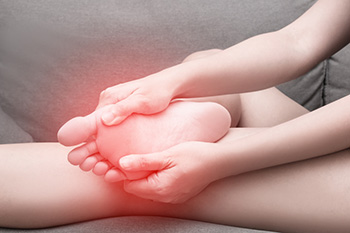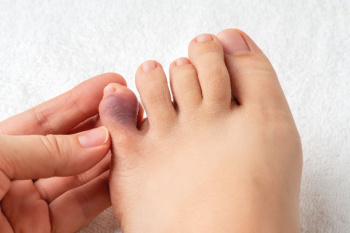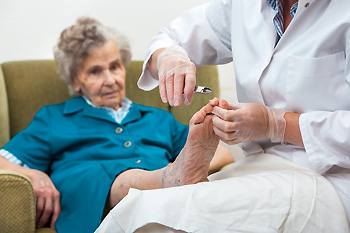November 2024
Causes of Pain in the Ball of the Foot

Pain in the ball of the foot, known as metatarsalgia, can result from various causes. Among them are stress fractures in the metatarsal bones, joint pain, and inflammation of the two sesamoid bones located under the big toe. Morton’s neuroma, a nerve-related issue, may also contribute to pain in the ball of the foot. It arises when nerves between the 3rd and 4th toes are compressed, often causing tingling and pain. Age-related thinning of the fat pad in this area can lead to less cushioning, increasing the likelihood of pain with walking or standing. Posture issues and biomechanical imbalances, which may result from poor gait mechanics, can put excessive pressure on the ball of the foot. Increased stress on the metatarsal area can encourage the development of secondary issues. A podiatrist can provide an accurate diagnosis and treatment plan to alleviate pain, prevent further complications, and help restore comfort. If you are experiencing pain in the ball of the foot, it is suggested that you make an appointment with a podiatrist for an exam and treatment.
Foot Pain
Foot pain can be extremely painful and debilitating. If you have a foot pain, consult with Dr. John C. Lawlor from Florida. Our doctor will assess your condition and provide you with quality foot and ankle treatment.
Causes
Foot pain is a very broad condition that could be caused by one or more ailments. The most common include:
- Bunions
- Hammertoes
- Plantar Fasciitis
- Bone Spurs
- Corns
- Tarsal Tunnel Syndrome
- Ingrown Toenails
- Arthritis (such as Gout, Rheumatoid, and Osteoarthritis)
- Flat Feet
- Injury (from stress fractures, broken toe, foot, ankle, Achilles tendon ruptures, and sprains)
- And more
Diagnosis
To figure out the cause of foot pain, podiatrists utilize several different methods. This can range from simple visual inspections and sensation tests to X-rays and MRI scans. Prior medical history, family medical history, and any recent physical traumatic events will all be taken into consideration for a proper diagnosis.
Treatment
Treatment depends upon the cause of the foot pain. Whether it is resting, staying off the foot, or having surgery; podiatrists have a number of treatment options available for foot pain.
If you have any questions, please feel free to contact one of our our offices located in Cape Coral and LaBelle, FL . We offer the newest diagnostic and treatment technologies for all your foot care needs.
Early Intervention for Clubfoot

Clubfoot, or congenital talipes equinovarus, is a birth defect in which one or both feet are twisted out of shape or position. In this condition, the foot is typically rotated inward and downward, with the affected foot’s heel pointing upward, causing the foot to appear club-like. It occurs in about one in every 1,000 births, and is more common in boys than girls. The exact cause of clubfoot is not fully understood, but genetic and environmental factors may play a role. If left untreated, clubfoot can lead to difficulties in walking and other mobility issues. Treatment typically begins shortly after birth, using the Ponseti method, which involves gentle manipulation and casting to gradually correct the position. In some cases, minor surgery may be necessary to release tight tendons. If your baby was born with clubfoot, it is strongly suggested that you seek early treatment from a podiatrist to achieve the best outcome.
Congenital foot problems require immediate attention to avoid future complications. If you have any concerns, contact Dr. John C. Lawlor of Florida. Our doctor can provide the care you need to keep you pain-free and on your feet.
Congenital foot problems are deformities affecting the feet, toes, and/or ankles that children are born with. Some of these conditions have a genetic cause while others just happen. Some specific foot ailments that children may be born with include clubfeet, polydactyly/macrodactyly, and cleft foot. There are several other foot anomalies that can occur congenitally. What all of these conditions have in common is that a child may experience difficulty walking or performing everyday activities, as well as trouble finding footwear that fits their foot deformity. Some of these conditions are more serious than others. Consulting with a podiatrist as early as possible will help in properly diagnosing a child’s foot condition while getting the necessary treatment underway.
What are Causes of Congenital Foot Problem?
A congenital foot problem is one that happens to a child at birth. These conditions can be caused by a genetic predisposition, developmental or positional abnormalities during gestation, or with no known cause.
What are Symptoms of Congenital Foot Problems?
Symptoms vary by the congenital condition. Symptoms may consist of the following:
- Clubfoot, where tendons are shortened, bones are shaped differently, and the Achilles tendon is tight, causing the foot to point in and down. It is also possible for the soles of the feet to face each other.
- Polydactyly, which usually consists of a nubbin or small lump of tissue without a bone, a toe that is partially formed but has no joints, or an extra toe.
- Vertical talus, where the talus bone forms in the wrong position causing other bones in the foot to line up improperly, the front of the foot to point up, and the bottom of the foot to stiffen, with no arch, and to curve out.
- Tarsal coalition, when there is an abnormal connection of two or more bones in the foot leading to severe, rigid flatfoot.
- Cleft foot, where there are missing toes, a V-shaped cleft, and other anatomical differences.
- Macrodactyly, when the toes are abnormally large due to overgrowth of the underlying bone or soft tissue.
Treatment and Prevention
While there is nothing one can do to prevent congenital foot problems, raising awareness and receiving neonatal screenings are important. Early detection by taking your child to a podiatrist leads to the best outcome possible.
If you have any questions please feel free to contact one of our our offices located in Cape Coral and LaBelle, FL . We offer the newest diagnostic tools and technology to treat your foot and ankle needs.
Understanding a Broken Pinky Toe

A broken pinky toe is a common injury that can happen in various ways, such as stubbing it against furniture, dropping something heavy on it, or experiencing repetitive stress from activities like running. If you have a broken pinky toe, you might experience sharp pain, swelling, bruising, and difficulty walking or wearing shoes comfortably. A podiatrist can diagnose a broken toe with a thorough physical examination and imaging tests, like X-rays, to assess the extent of the injury. For treatment, buddy taping the injured pinky toe to the adjacent toe can provide stability. In more severe cases, a special shoe may be recommended to restrict movement and protect the toe during healing. Recovery usually takes about four to six weeks, but this can vary depending on the severity of the fracture and your overall health. If you think you might have a broken pinky toe, it is suggested that you schedule an appointment with a podiatrist. They can provide the right diagnosis and treatment plan to ensure proper healing.
A broken toe can be very painful and lead to complications if not properly fixed. If you have any concerns about your feet, contact Dr. John C. Lawlor from Florida. Our doctor will treat your foot and ankle needs.
What to Know About a Broken Toe
Although most people try to avoid foot trauma such as banging, stubbing, or dropping heavy objects on their feet, the unfortunate fact is that it is a common occurrence. Given the fact that toes are positioned in front of the feet, they typically sustain the brunt of such trauma. When trauma occurs to a toe, the result can be a painful break (fracture).
Symptoms of a Broken Toe
- Throbbing pain
- Swelling
- Bruising on the skin and toenail
- The inability to move the toe
- Toe appears crooked or disfigured
- Tingling or numbness in the toe
Generally, it is best to stay off of the injured toe with the affected foot elevated.
Severe toe fractures may be treated with a splint, cast, and in some cases, minor surgery. Due to its position and the pressure it endures with daily activity, future complications can occur if the big toe is not properly treated.
If you have any questions please feel free to contact one of our our offices located in Cape Coral and LaBelle, FL . We offer the newest diagnostic and treatment technologies for all your foot and ankle needs.
Keep Your Feet Healthy So You Can Stay Active
Elderly Foot Care to Prevent Falls

Footwear plays a vital role in preventing falls among the elderly, who are more prone to balance issues and foot problems. Choosing the right shoes can significantly reduce the risk of falls. Seniors should wear shoes with non-slip soles, good arch support, and a snug fit. Shoes with a low heel and a wide, stable base are ideal for maintaining balance. Avoid walking in slippers, sandals, or shoes with worn-out soles, as they can increase the chance of slipping. Regular foot care is also essential. Keeping toenails trimmed, checking for signs of pain, and addressing conditions like bunions or hammertoes early can improve comfort and stability. If you are elderly, it is suggested that you visit a podiatrist regularly to ensure any underlying foot problems are addressed promptly, helping to maintain mobility and prevent falls.
Proper foot care is something many older adults forget to consider. If you have any concerns about your feet and ankles, contact Dr. John C. Lawlor from Florida. Our doctor can provide the care you need to keep you pain-free and on your feet.
The Elderly and Their Feet
As we age we start to notice many changes in our body, but the elder population may not notice them right away. Medical conditions may prevent the elderly to take notice of their foot health right away. Poor vision is a lead contributor to not taking action for the elderly.
Common Conditions
- Neuropathy – can reduce feeling in the feet and can hide many life-threatening medical conditions.
- Reduced flexibility – prevents the ability of proper toenail trimming, and foot cleaning. If left untreated, it may lead to further medical issues.
- Foot sores – amongst the older population can be serious before they are discovered. Some of the problematic conditions they may face are:
- Gouging toenails affecting nearby toe
- Shoes that don’t fit properly
- Pressure sores
- Loss of circulation in legs & feet
- Edema & swelling of feet and ankles
Susceptible Infections
Diabetes and poor circulation can cause general loss of sensitivity over the years, turning a simple cut into a serious issue.
If you have any questions please feel free to contact one of our our offices located in Cape Coral and LaBelle, FL . We offer the newest diagnostic and treatment technologies for all your foot and ankle needs.









